![Sliced and prepared Ikiilgin (Ikii[?]gin) Mattak.jpg](http://upload.wikimedia.org/wikipedia/commons/thumb/1/14/Mattak.jpg/300px-Mattak.jpg)
Chukchi cuisine refers to subsistence foods and their methods of preparation used by the Chukchi people, one of the indigenous peoples of Siberia. [1]
![Sliced and prepared Ikiilgin (Ikii[?]gin) Mattak.jpg](http://upload.wikimedia.org/wikipedia/commons/thumb/1/14/Mattak.jpg/300px-Mattak.jpg)
Chukchi cuisine refers to subsistence foods and their methods of preparation used by the Chukchi people, one of the indigenous peoples of Siberia. [1]
The conquest of Siberia by the Russian Empire in the 16th and 17th centuries, followed by smallpox and other epidemics, and then eventually the Soviet collectivization of the 20th century, led to great changes in the lives and diets of the Chukchi people. They are now mostly settled in towns in the Chukotka Autonomous Okrug and surrounding areas, and regularly consume bread, vodka, and other food derived from agriculture and industrial production. Chukchi cuisine has over the centuries been heavily influenced by Russian cuisine. Preparation techniques include cooking on a hot stone, boiling, fermentation, and raw consumption.
The traditional cuisine is heavily dependent on meat, particularly reindeer meat and whale meat. The Chukchi were split into two groups, each with a different lifestyle. The Reindeer Chukchi, who called themselves the Chauchu ("rich in reindeer"), were semi-nomadic reindeer herders that inhabited the inland tundra. [2] The Maritime Chukchi, on the other hand, who were called Anqallyt ("sea (people)"), were settled whale hunters who inhabited the coastal areas.
Some dishes prepared by the Chukchi include: [3] [4]
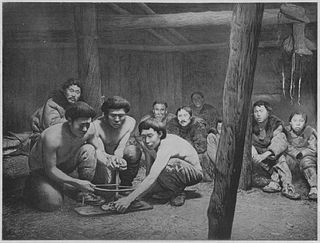
Koryaks are an indigenous people of the Russian Far East, who live immediately north of the Kamchatka Peninsula in Kamchatka Krai and inhabit the coastlands of the Bering Sea. The cultural borders of the Koryaks include Tigilsk in the south and the Anadyr basin in the north.
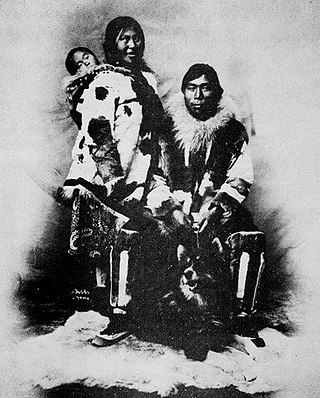
The Chukchi, or Chukchee, are a Siberian indigenous people native to the Chukchi Peninsula, the shores of the Chukchi Sea and the Bering Sea region of the Arctic Ocean all within modern Russia. They speak the Chukchi language. The Chukchi originated from the people living around the Okhotsk Sea. According to several studies on genomic research conduct from 2014 to 2018, the Chukchi are one of the Indigenous peoples of Siberia. They are also the closest Asiatic relatives of the indigenous peoples of the Americas as well as of the Ainu people and other East Asian people, being the descendants of settlers who did not cross the Bering Strait or settle the Japanese archipelago.

A sausage is a type of meat product usually made from ground meat—often pork, beef, or poultry—along with salt, spices and other flavourings. Other ingredients, such as grains or breadcrumbs may be included as fillers or extenders.

Finnish cuisine is notable for generally combining traditional country fare and haute cuisine with contemporary continental-style cooking. Fish and meat play a prominent role in traditional Finnish dishes in some parts of the country, while the dishes elsewhere have traditionally included various vegetables and mushrooms. Evacuees from Karelia contributed to foods in other parts of Finland in the aftermath of the Continuation War.

A blood sausage is a sausage filled with blood that is cooked or dried and mixed with a filler until it is thick enough to solidify when cooled. Most commonly, the blood of pigs, sheep, lamb, cow, chicken, or goose is used.

Offal, also called variety meats, pluck or organ meats, is the internal organs of a butchered animal. The word does not refer to a particular list of edible organs, and these lists of organs vary with culture and region, but usually exclude skeletal muscle. Offal may also refer to the by-products of human meat or of milled grains, such as corn or wheat.

Czech cuisine has both influenced and been influenced by the cuisines of surrounding countries and nations. Many of the cakes and pastries that are popular in Central Europe originated within the Czech lands. Contemporary Czech cuisine is more meat-based than in previous periods; the current abundance of farmable meat has enriched its presence in regional cuisine. Traditionally, meat has been reserved for once-weekly consumption, typically on weekends.

Muktuk is a traditional food of the peoples of the Arctic, consisting of whale skin and blubber. It is most often made from the bowhead whale, although the beluga and the narwhal are also used. It is usually consumed raw, but can also be eaten frozen, cooked, or pickled.

Traditional Kazakh cuisine is the traditional food of the Kazakh people. It is focused on mutton and horse meat, as well as various milk products. For hundreds of years, Kazakhs were herders who raised fat-tailed sheep, Bactrian camels, and horses, relying on these animals for transportation, clothing, and food. The cooking techniques and major ingredients have been strongly influenced by the nation's nomadic way of life. For example, most cooking techniques are aimed at long-term preservation of food. There is a large practice of salting and drying meat so that it will last, and there is a preference for sour milk, as it is easier to save in a nomadic lifestyle.
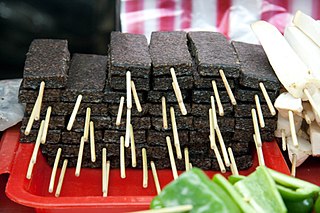
Blood as food is the usage of blood on food, religiously and culturally. Many cultures consume blood, often in combination with meat. The blood may be in the form of blood sausage, as a thickener for sauces, a cured salted form for times of food scarcity, or in a blood soup. This is a product from domesticated animals, obtained at a place and time where the blood can run into a container and be swiftly consumed or processed. In many cultures, the animal is slaughtered. In some cultures, blood is a taboo food.

Kyrgyz cuisine is the cuisine of the Kyrgyz, who comprise a majority of the population of Kyrgyzstan. The cuisine is similar in many aspects to that of their neighbors.

Historically Inuit cuisine, which is taken here to include Greenlandic cuisine, Yup'ik cuisine and Aleut cuisine, consisted of a diet of animal source foods that were fished, hunted, and gathered locally.

Greenlandic cuisine is traditionally based on meat from marine mammals, birds, and fish, and normally contains high levels of protein. Since colonization and the arrival of international trade, the cuisine has been increasingly influenced by Danish, British, American and Canadian cuisine. During the summer when the weather is milder, meals are often eaten outdoors.
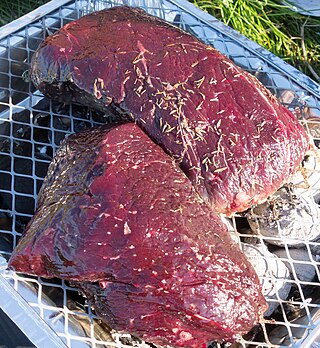
Whale meat, broadly speaking, may include all cetaceans and all parts of the animal: muscle (meat), organs (offal), skin (muktuk), and fat (blubber). There is relatively little demand for whale meat, compared to farmed livestock. Commercial whaling, which has faced opposition for decades, continues today in very few countries, despite whale meat being eaten across Western Europe and colonial America previously. However, in areas where dolphin drive hunting and aboriginal whaling exist, marine mammals are eaten locally as part of a subsistence economy: the Faroe Islands, the circumpolar Arctic, other indigenous peoples of the United States, St. Vincent and the Grenadines, some of villages in Indonesia and in certain South Pacific islands.

Traditional Yamal cuisine is an important part of national culture of Nenets, Khanty and Komi. Yamal is a hunting and fishing land so many dishes include meat, fowl and fish. Berries and mushrooms are also abundant; this accounts for the wealth of "gifts of the forests" on the Yamal table. Presently, Yamal cuisine is renowned for diverse delicacies of Russian cuisine. Yamal hosts enjoy treating their guests with traditional Yamal cuisine and have hot tea which came to Yamal cuisine from Russia. Tea has become the national Yamal beverage, drunk to warm and soothe. Yamal is in northern Russia with frigid winters, so its cuisine should be nourishing to give the people energy to survive during the long winter time. The essential component of Yamal cuisine is warm and hot dishes. Fresh fruits and vegetables are rarely used as they must be imported, as they are not grown in the tundra. The Yamal cuisine is associated with malosol and stroganina. Yamal cuisine has absorbed techniques from other regions. Yamal cuisine is based on reindeer meat and fish of the Yamal rivers, enriched with mushrooms and bread.

Nettle soup is a traditional soup prepared from stinging nettles. Nettle soup is eaten mainly during spring and early summer, when young nettle buds are collected. Today, nettle soup is mostly eaten in Scandinavia, Iran, Ireland, and Eastern Europe, with regional differences in recipe; however historically consumption of nettles was more widespread.

Reindeer in Siberian shamanism reflect the cultural, as well as the economic, relationship between the native peoples of Siberia, a region of Northern Asia, and the reindeer that live there. It involves the nomadic reindeer herders, those that hunt wild reindeer and those who maintain domesticated ones. Their religious beliefs reflect the spiritual philosophy of shamanism, and their traditions often involve reindeer in several steps of the process of practicing their religion.
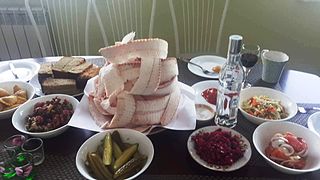
Stroganina is a dish of the northern Russians and indigenous people of northern Arctic Siberia consisting of raw, thin, long-sliced frozen fish. Around Lake Baikal, the dish is referred to as raskolotka. Traditional stroganina is made with freshwater whitefish salmonids found in the Siberian Arctic waters such as nelma, muksun, chir, and omul. Rarely, it is made with sturgeon. This dish is popular with native Siberians, and is present in Yakutian cuisine, Eskimo cuisine, Komi cuisine and Yamal cuisine. It is often paired with vodka.

Yup'ik cuisine refers to the Eskimo style traditional subsistence food and cuisine of the Yup'ik people from the western and southwestern Alaska. Also known as Cup'ik cuisine for the Chevak Cup'ik dialect speaking Eskimos of Chevak and Cup'ig cuisine for the Nunivak Cup'ig dialect speaking Eskimos of Nunivak Island. This cuisine is traditionally based on meat from fish, birds, sea and land mammals, and normally contains high levels of protein. Subsistence foods are generally considered by many to be nutritionally superior superfoods. Yup’ik diet is different from Alaskan Inupiat, Canadian Inuit, and Greenlandic diets. Fish as food are primary food for Yup'ik Eskimos. Both food and fish called neqa in Yup'ik. Food preparation techniques are fermentation and cooking, also uncooked raw. Cooking methods are baking, roasting, barbecuing, frying, smoking, boiling, and steaming. Food preservation methods are mostly drying and less often frozen. Dried fish is usually eaten with seal oil. The ulu or fan-shaped knife used for cutting up fish, meat, food, and such.

Sakha cuisine encompasses the customary and traditional cooking techniques and culinary arts of Sakha.